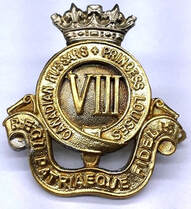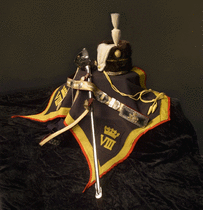A Brief History of the Regiment

The 8th Canadian Hussars (Princess Louise’s) is Canada’s oldest armoured regiment with its official history dating back to April 4, 1848. The Regiment has continuously served Canada since that date. Although originally established in communities along the Kennebecasis River, during the many years of its existence, the Regiment has expanded to many other communities such as Sackville, Moncton, Shediac, St. Martins and Petitcodiac.
Hussars in New Brunswick were mostly farm and factory workers from the river valleys and fields and small towns in the southern half of the province. For most of the Regiment’s history, beginning in 1848, they were part-time, or militia soldiers. In the early days, they brought their own horses from the farm to train at Camp Sussex. The men were paid more for the upkeep of their horses than they earned themselves. In the 1930's, horses were exchanged for motorized vehicles and tanks. Although horses were no longer part of a modern army, the “Hussar” spirit remained.
When wars came, hundreds of Hussars joined the active service army and served with distinction on battlefields in France and Flanders in World War I, and in Italy and Holland in World War II. They also served later in Europe under NATO in the Middle and Far East and in Cyprus as peace-keepers for the United Nations.
Today, 8th Hussars are again militia soldiers, continuing to supply men and women to support the regular army in places such as Afghanistan where Canada has committed its forces.
Hussars in New Brunswick were mostly farm and factory workers from the river valleys and fields and small towns in the southern half of the province. For most of the Regiment’s history, beginning in 1848, they were part-time, or militia soldiers. In the early days, they brought their own horses from the farm to train at Camp Sussex. The men were paid more for the upkeep of their horses than they earned themselves. In the 1930's, horses were exchanged for motorized vehicles and tanks. Although horses were no longer part of a modern army, the “Hussar” spirit remained.
When wars came, hundreds of Hussars joined the active service army and served with distinction on battlefields in France and Flanders in World War I, and in Italy and Holland in World War II. They also served later in Europe under NATO in the Middle and Far East and in Cyprus as peace-keepers for the United Nations.
Today, 8th Hussars are again militia soldiers, continuing to supply men and women to support the regular army in places such as Afghanistan where Canada has committed its forces.

Royalty and the Regiment: The 8th Hussars have had a long association with Royalty. In 1879 after mounting a Guard for the Governor General of Canada and his wife, HRH Princess Louise, the Regiment sought and was given permission to add her name to their title in 1884. It was only fitting that they would name a wounded colt, rescued in the fighting in Italy during WW2, and retained as a mascot, Princess Louise. This horse went on to be given the Freedom of the Town in Hampton on her arrival from Europe and eventually would have two foals of her own, aptly named Princess Louise II and III. In 1972 HRH Princess Anne, Princess Royal became the Colonel-in-Chief of the 8th Canadian Hussars (Princess Louise’s) and has been an integral part of the pomp and ceremony associated with the Regiment since that time. She has visited the Regiment on many occasions, most recently with with her visit in 2023 to help the Regiment celebrate their 175th birthday celebration in Moncton and Sussex, NB.
WHAT IS A HUSSAR?
A Hussar was a lightly-armed – sword and no personal armour – cavalry or horse soldier in Hungary in the 15th century. Hussars were much admired by armies of other countries for their spirit, dash and daring, and perhaps even their uniforms. Copying this tradition, the 8th Hussars Regiment was formed in New Brunswick.
LOCAL REGIMENTAL SITES OF INTEREST
Numerous sites are within minutes of the museum, which have played prominent parts in the life of the Regiment.
1. Camp Sussex opened in the 1880’s and located just up the street, has been home to the Regiment since that time.
2. Fox Hill Cairn is dedicated to the founding of the Regiment and is located at the home of the first commanding officer. It is found just 4 km down Route 121 at Fox Hill.
3 A WWII Sherman Tank is displayed at the Milton Gregg VC Armories on the grounds of Camp Sussex.
4. Princess Louise I & III’s burial site is at Hampton, NB. Two of the Regiments three mascots are buried at the War Memorial in Hampton, NB.
WHAT IS A HUSSAR?
A Hussar was a lightly-armed – sword and no personal armour – cavalry or horse soldier in Hungary in the 15th century. Hussars were much admired by armies of other countries for their spirit, dash and daring, and perhaps even their uniforms. Copying this tradition, the 8th Hussars Regiment was formed in New Brunswick.
LOCAL REGIMENTAL SITES OF INTEREST
Numerous sites are within minutes of the museum, which have played prominent parts in the life of the Regiment.
1. Camp Sussex opened in the 1880’s and located just up the street, has been home to the Regiment since that time.
2. Fox Hill Cairn is dedicated to the founding of the Regiment and is located at the home of the first commanding officer. It is found just 4 km down Route 121 at Fox Hill.
3 A WWII Sherman Tank is displayed at the Milton Gregg VC Armories on the grounds of Camp Sussex.
4. Princess Louise I & III’s burial site is at Hampton, NB. Two of the Regiments three mascots are buried at the War Memorial in Hampton, NB.